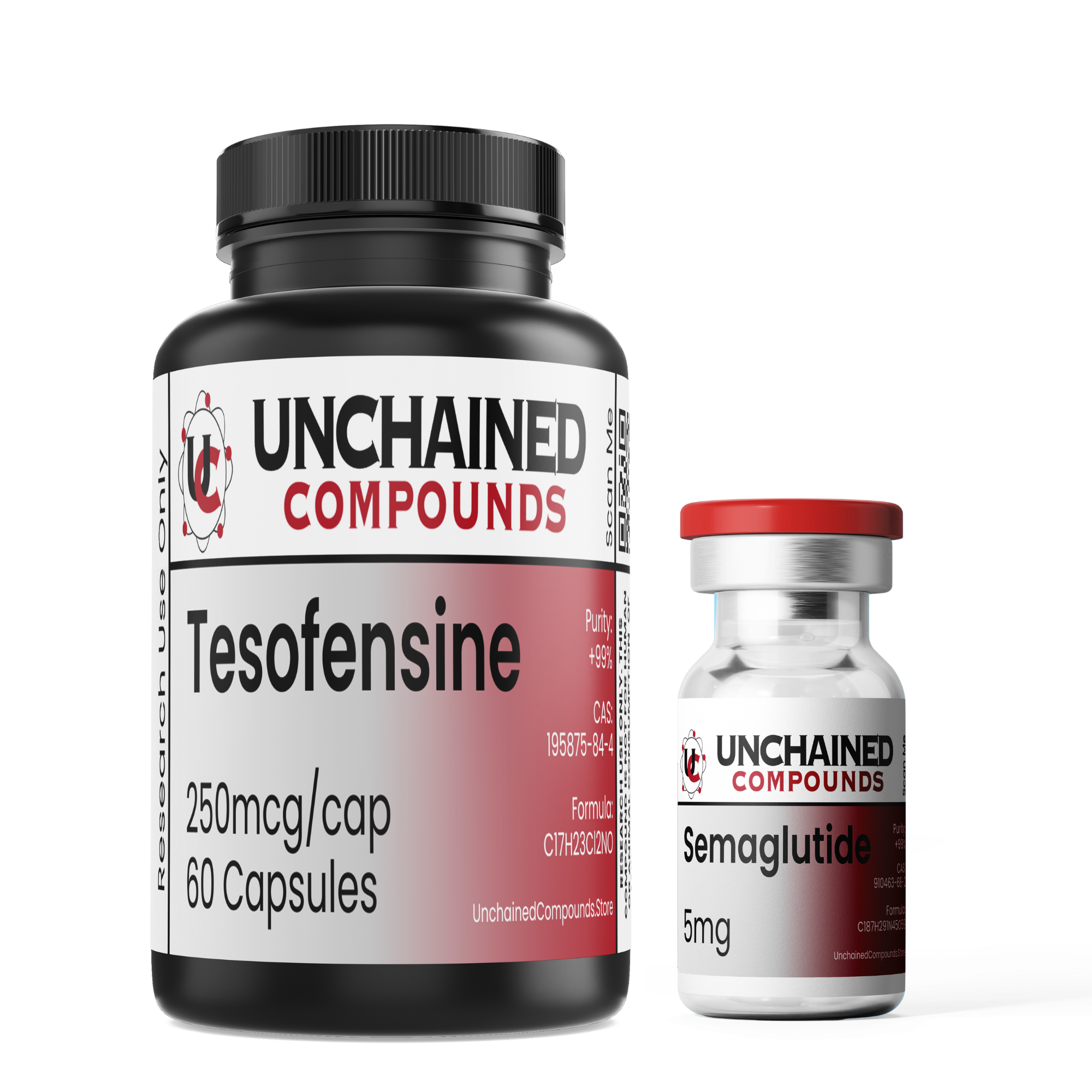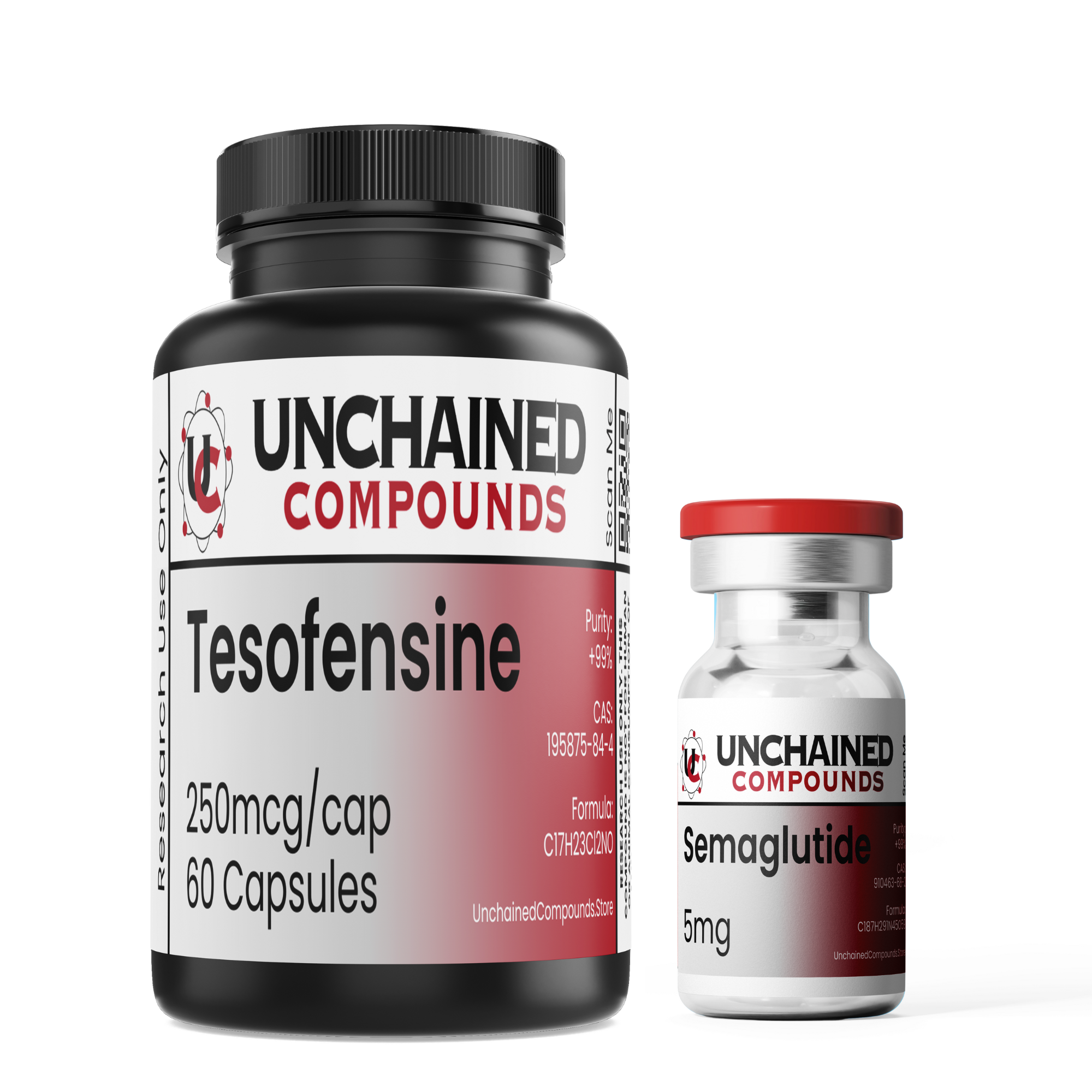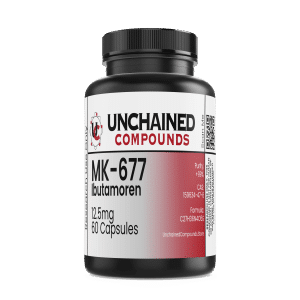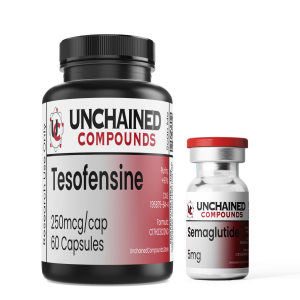Description







Tesofensine is a serotonin-noradrenaline-dopamine reuptake inhibitor which was originally studied for its effect on Parkinson’s and Alzheimer’s. Unfortunately, its exploration for these indications were limited because the research subjects starting losing too much weight. Since then, tesofensine has been studied as a way to treat obesity via its ability to reduce appetite. This molecular compound indirectly stimulates the cholinergic system and showed to be more successful than other weight loss agents. Tesofensine (TE) increases transmission of 3 monoaminergic neurotransmitters in the brain. These neurotransmitters are serotonin, norepinephrine, and dopamine which help regulate energy balance and are linked to obesity and depression. On average, its 6-month weight loss results from a phase 2b clinical trial resulted in a weight loss of around 25 pounds. TE research has shown a pronounced effect on appetite sensations and a slight effect on energy expenditure. Both effects can contribute to the strong weight reducing effect.
Semaglutide is a derivative of the naturally occurring GLP-1, a peptide known to lower blood sugar levels and enhance insulin secretion. Research shows that Semaglutide may also improve heart, liver, and lung function while helping to slow or prevent the effects of Alzheimer’s disease. Semaglutide has been shown to significantly decrease appetite by delaying gastric emptying and reducing intestinal motility. Glucagon-Like Peptide-1 (GLP-1) Analog Shown to Stimulate Insulin and Suppress Glucagon Secretion in a Glucose-Dependent Manner.
Properties
Tesofensine
- Chemical Formula: C17H23Cl2NO
- Molecular Mass: 328.28 g/mol
- Synonyms:
- CAS Number: 195875-84-4
- PubChem: 11370864
- Total Amount of the Active Ingredient: 250mcg per capsule – 60 Capsules
- Shelf Life: 36 months
Semaglutide
- Chemical Formula: C62H98N16O22
- Molecular Weight: 4144g/mol
- Synonyms: Semaglutide; Rybelsus; NN9535; 910463-68-2; UNII-53AXN4NNHX; NN 9535
- PubChem: 56843331
- CAS#: 910463-68-2
- Total Amount of the Active Ingredient: 5 mg (1 vial)
- Shelf Life: 36 months
Research Studies
Weight loss produced by Tesofensine in patients with Parkinson’s or Alzheimer’s disease
Abstract
Objective: Tesofensine (TE) is a norepinephrine, dopamine, and serotonin reuptake inhibitor. We conducted a meta-analysis of TE’s effect on body weight in trials investigating its potential for treatment of Parkinson’s or Alzheimer’s disease.
Methods and procedures: Four randomized, double-blind, multicenter trials compared TE (n = 740) and placebo (n = 228), two in each disease. Patients received oral TE or placebo once daily for 14 weeks without any weight loss program. Results were adjusted for baseline values, age, and study.
Results: In the placebo group, 14% were obese and 21% were in the TE group. In the total cohort, weight change after 14 weeks was +0.5, -0.5, -0.9, -1.8, -2.8% in the placebo, 0.125, 0.25, 0.5 and 1.0 mg in the TE groups, respectively (P = 0.015 for dose effect). In the obese subgroup, weight changes were -0.2, -1.7, -1.6, -1.5, -3.7%, and 2.1, 8.2, 14.1, 20.9, 32.1% of the obese patients achieved > or = 5% weight loss (P < 0.001 for 0.25, 0.5, and 1.0 mg vs. placebo for both end points). Changes in heart rate were -0.4, 2.1, 4.2, 6.0, and 6.8 bpm after 14 weeks (TE vs. placebo: P < 0.001 from 0.25 mg), but no effect on blood pressure was observed.
Discussion: TE produced a placebo-subtracted weight loss of approximately 4% for >14 weeks without any diet and lifestyle therapy, which is similar to that of sibutramine, but with no effect on blood pressure. On the basis of these results, TE is now being developed for obesity management.
Abstract
Tesofensine is a novel monoamine reuptake inhibitor that inhibits both norepinephrine, 5-HT, and dopamine (DA) reuptake function. Tesofensine is currently in clinical development for the treatment of obesity, however, the pharmacological basis for its strong effect in obesity management is not clarified. Using a rat model of diet-induced obesity (DIO), we characterized the pharmacological mechanisms underlying the appetite suppressive effect of tesofensine. DIO rats treated with tesofensine (2.0 mg/kg, s.c.) for 16 days showed significantly lower body weights than vehicle-treated DIO rats, being reflected by a marked hypophagic response. Using an automatized food intake monitoring system during a 12 h nocturnal test period, tesofensine-induced hypophagia was investigated further by studying the acute interaction of a variety of monoamine receptor antagonists with tesofensine-induced hypophagia in the DIO rat. Tesofensine (0.5-3.0 mg/kg, s.c.) induced a dose-dependent and marked decline in food intake with an ED(50) of 1.3 mg/kg. The hypophagic response of tesofensine (1.5 mg/kg, s.c.) was almost completely reversed by co-administration of prazosin (1.0 mg/kg, alpha(1) adrenoceptor antagonist) and partially antagonized by co-administration of SCH23390 (0.03 mg/kg, DA D(1) receptor antagonist). In contrast, tesofensine-induced hypophagia was not affected by RX821002 (0.3 mg/kg, alpha(2) adrenoceptor antagonist), haloperidol (0.03 mg/kg, D(2) receptor antagonist), NGB2904 (0.1 mg/kg, D(3) receptor antagonist), or ritanserin (0.03 mg/kg, 5-HT(2A/C) receptor antagonist). Hence, the mechanism underlying the suppression of feeding by tesofensine in the obese rat is dependent on the drug’s ability to indirectly stimulate alpha(1) adrenoceptor and DA D(1) receptor function.
Abstract
Background: Tesofensine (TE) is a new drug producing twice the weight loss in obese individuals as seen with currently marketed drugs. It inhibits the presynaptic reuptake of the neurotransmitters noradrenaline, dopamine and serotonin, and is thought to enhance the neurotransmission of all three monoamines. The mechanisms by which it produces weight loss in humans are unresolved.
Objective: The aim of this study is to investigate the mechanism(s) behind weight reduction by measuring energy expenditure and appetite sensations in overweight and obese individuals.
Design: Thirty-two healthy, overweight or moderately obese men were treated with 2.0 mg TE daily for 7 days followed by an additional 7 days with 1.0 mg TE daily or corresponding placebo (PL) in a randomized, controlled trial. They were instructed to maintain habitual food intake and physical activity throughout. Twenty-four-hour energy expenditure (24-h EE), fat oxidation and spontaneous physical activity were measured in a respiration chamber before and after treatment. Body composition was assessed by dual-energy X-ray absorption and appetite was evaluated by visual analogue scales in conjunction with a standardized dinner.
Results: Despite efforts to keep body weight and composition constant, TE induced a 1.8 kg weight loss above PL after 2 weeks’ treatment (P<0.0001). TE also induced higher ratings of satiety and fullness and concomitantly lower prospective food intake than placebo. No significant effect of TE on total 24-h EE could be demonstrated compared with PL, but higher energy expenditure was observed during the night period (4.6%; P<0.05) when adjusted for changes in body composition. Furthermore, TE increased 24-h fat oxidation as compared with PL (18 g; P<0.001).
Conclusion: TE has a pronounced effect on appetite sensations and a slight effect on energy expenditure at night-both effects can contribute to the strong weight-reducing effect of TE.
Wegovy (semaglutide): a new weight loss drug for chronic weight management
Abstract
Obesity is a growing epidemic within the USA. Because weight gain is associated with an increased risk of developing life-threatening comorbidities, such as hypertension or type 2 diabetes, there is great interest in developing non-invasive pharmacotherapeutics to help combat obesity. Glucagon-like peptide-1 (GLP-1) receptor agonists are a class of antidiabetic medications that have shown promise in encouraging glycemic control and promoting weight loss in patients with or without type 2 diabetes. This literature review summarizes and discusses the weight loss results from the SUSTAIN (Semaglutide Unabated Sustainability in Treatment of Type 2 Diabetes), PIONEER (Peptide Innovation for Early Diabetes Treatment), and STEP (Semaglutide Treatment Effect in People with Obesity) clinical trial programs. The SUSTAIN and PIONEER clinical trials studied the use of 1.0 mg, once-weekly, subcutaneous and oral semaglutide (a new GLP-1 homolog), respectively, on participants with type 2 diabetes. The STEP trial examined the effects of 2.4 mg, once-weekly, subcutaneous semaglutide on patients with obesity. Trial data and other pertinent articles were obtained via database search through the US National Library of Medicine Clinical Trials and the National Center for Biotechnology Information. All three clinical trials demonstrated that semaglutide (injected or oral) has superior efficacy compared with placebo and other antidiabetic medications in weight reduction, which led to Food and Drug Administration approval of Wegovy (semaglutide) for weight loss.
Abstract
The glucagon-like peptide-1 receptor agonist (GLP-1RA) semaglutide is the most recently approved agent of this drug class, and the only GLP-1RA currently available as both subcutaneous and oral formulation. While GLP-1RAs effectively improve glycemic control and cause weight loss, potential safety concerns have arisen over the years. For semaglutide, such concerns have been addressed in the extensive phase 3 registration trials including cardiovascular outcome trials for both subcutaneous (SUSTAIN: Semaglutide Unabated Sustainability in Treatment of Type 2 Diabetes) and oral (PIONEER: Peptide InnOvatioN for the Early diabEtes tReatment) semaglutide and are being studied in further trials and registries, including real world data studies. In the current review we discuss the occurrence of adverse events associated with semaglutide focusing on hypoglycemia, gastrointestinal side effects, pancreatic safety (pancreatitis and pancreatic cancer), thyroid cancer, gallbladder events, cardiovascular aspects, acute kidney injury, diabetic retinopathy (DRP) complications and injection-site and allergic reactions and where available, we highlight potential underlying mechanisms. Furthermore, we discuss whether effects are specific for semaglutide or a class effect. We conclude that semaglutide induces mostly mild-to-moderate and transient gastrointestinal disturbances and increases the risk of biliary disease (cholelithiasis). No unexpected safety issues have arisen to date, and the established safety profile for semaglutide is similar to that of other GLP-1RAs where definitive conclusions for pancreatic and thyroid cancer cannot be drawn at this point due to low incidence of these conditions. Due to its potent glucose-lowering effect, patients at risk for deterioration of existing DRP should be carefully monitored if treated with semaglutide, particularly if also treated with insulin. Given the beneficial metabolic and cardiovascular actions of semaglutide, and the low risk for severe adverse events, semaglutide has an overall favorable risk/benefit profile for patient with type 2 diabetes.
Abstract
Aim: The aim of this trial was to investigate the mechanism of action for body weight loss with semaglutide.
Materials and methods: This randomised, double-blind, placebo-controlled, two-period crossover trial investigated the effects of 12 weeks of treatment with once-weekly subcutaneous semaglutide, dose-escalated to 1.0 mg, in 30 subjects with obesity. Ad libitum energy intake, ratings of appetite, thirst, nausea and well-being, control of eating, food preference, resting metabolic rate, body weight and body composition were assessed.
Results: After a standardised breakfast, semaglutide, compared with placebo, led to a lower ad libitum energy intake during lunch (-1255 kJ; P < .0001) and during the subsequent evening meal ( P = .0401) and snacks ( P = .0034), resulting in a 24% reduction in total energy intake across all ad libitum meals throughout the day (-3036 kJ; P < .0001). Fasting overall appetite suppression scores were improved with semaglutide vs placebo, while nausea ratings were similar. Semaglutide was associated with less hunger and food cravings, better control of eating and a lower preference for high-fat foods. Resting metabolic rate, adjusted for lean body mass, did not differ between treatments. Semaglutide led to a reduction from baseline in mean body weight of 5.0 kg, predominantly from body fat mass.
Conclusion: After 12 weeks of treatment, ad libitum energy intake was substantially lower with semaglutide vs placebo with a corresponding loss of body weight observed with semaglutide. In addition to reduced energy intake, likely mechanisms for semaglutide-induced weight loss included less appetite and food cravings, better control of eating and lower relative preference for fatty, energy-dense foods.
Disclaimer
The information provided above is not intended to substitute medical advice, diagnosis, or treatment. Should you have any questions regarding a medical condition, seek the advice of your physician or a qualified healthcare provider. In no case should medical advice be disregarded or delayed because of what you have read or seen. We bear no responsibility or liability for your use of any of our research compounds and products. Please note that they are being sold for research purposes ONLY. We do NOT condone any personal use.
NOTE: In some cases wherein the assigned top colors are out of stock, a different top color will be used to ensure that your order will not be delayed. Should you need assistance identifying the peptide vial that you received, please send us an email at support@unchainedcompounds.store.
ALL ARTICLES AND PRODUCT INFORMATION PROVIDED ON THIS WEBSITE ARE FOR INFORMATIONAL AND EDUCATIONAL PURPOSES ONLY.
The products offered on this website are intended for in-vitro studies only. In-vitro studies (Latin: “in glass”) are performed outside the body. These products are not medicines or drugs and have not been approved by the FDA to prevent, treat, or cure any medical condition, ailment, or disease. Bodily introduction of any kind into humans or animals is strictly forbidden by law.








